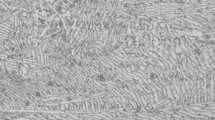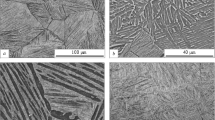Conclusions
-
1.
The use of carbon isotope14C in a study of 8-ton commerical ingot of titanium pseudo-α-alloy 1000 mm in diameter allowed us to establish that carbon macrosegregation does not develop in the volume of the metal.
-
2.
The uniform distribution of carbon in the solid solution after quenching and its susceptibility toward directed redistribution in slow cooling show that it is possible to change the properties of titanium pseudo-α-alloys alloyed with carbon by changing the heat-treatment regime.
-
3.
The decisive role in the carbon distribution in technological heatings and thermomechanical treatment of specimens of titanium pseudo-α-alloy quenched in water from 1200°C is played by the cooling rate rather than the heating temperature.
Similar content being viewed by others
References
B. A. Kolachev, V. A. Livanov, and A. A. Bukhanova,Mechanical Properties of Titanium and Its Alloys [in Russian], Metallurgiya, Moscow (1974).
I. N. Golikov and S. B. Maslenkov,Dendritic Segregation in Steels and Alloys [in Russian], Metallurgiya, Moscow (1977).
B. I. Bruk,Autoradiographic Study of Shipbuilding Metals [in Russian], Sudostroenie, Moscow (1966).
Preparation and Introduction of RAI into Ingots of Titanium Alloys for Studying the Inhomogeneity of the Composition. Methodological Recommendations MR 155-4-82 [in Russian], VILS (1982).
E. A. Karasev, I. V. Polin, and B. A. Kuznetsov, “A study of the distribution of hydrogen, carbon, and sulfur in cast metal by the method of radioactive isotopes”, in:Vacuum Arc Melting of Metals and Alloys, Sbornik ONTI VILS, Issue 4 [in Russian] (1966).
S. Z. Bokshtein, S. S. Ginzburg, S. T. Kishkin, and L. S. Moroz,Electron Microscopic Autoradiography in Metal Science [in Russian], Metallurgiya, Moscow (1978).
S. Z. Bokshtein, T. A. Emel’yanova, S. G. Kishkin, and L. M. Mirskii,Metals, Coll. Works, No. 65 [in Russian] (1968).
Yu. F. Babikova, G. G. Ryabova, and P. L. Gruzin, “Distribution of carbon admixtures in zirconïum and titanium”, in:Metallurgy and Metal Science of Pure Metals, Coll. Works, Issue III [in Russian], Atomizdat, Moscow (1961).
I. I. Kornilov,Titanium [in Russian], Nauka, Moscow (1975).
B. A. Movchan,Crystal Boundaries in Cast Metals and Alloys [in Russian], Tekhnika, Kiev (1970).
Additional information
Translated from Metallovedenie i Termicheskaya Obrabotka Metallov, No. 9, pp. 44–47, September, 1999.
Rights and permissions
About this article
Cite this article
Ushkov, S.S., Kudryavtsev, A.S. & Karasev, É.A. Special features of the distribution of interstitial elements in cast and deformed titanium pseudo-α-alloy. Met Sci Heat Treat 41, 408–411 (1999). https://doi.org/10.1007/BF02469880
Issue Date:
DOI: https://doi.org/10.1007/BF02469880




